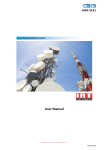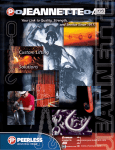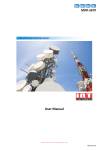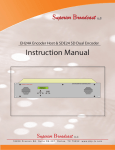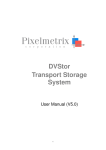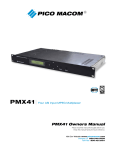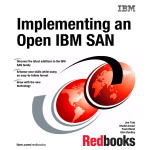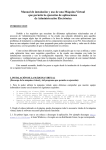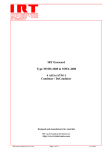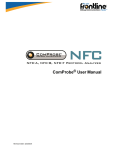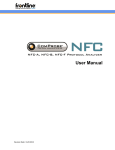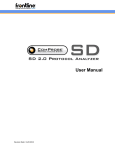Download MDT-3670 User Manual (Revision 09)
Transcript
MDT-3670 ASI to ASI & G.703 Network Interface Adapter User Manual IRT Electronics Pty Ltd | www.irtelectronics.com Revision 09 MDT-3670 ASI TO ASI & G.703 NETWORK INTERFACE ADAPTER Revision History: Revision 00 01 02 03 Date 08/02/2005 20/12/2006 15/10/2007 14/04/2008 By AL AL AL AL 04 04/08/2009 AL 05 16/10/2009 AL 06 07 08 09 08/12/2009 14/07/2010 03/05/2011 23/05/2012 AL AL AL AL Change Description Original Issue. Unused SW4 settings listed in configuration section. Sw4-4 settings functions added. Front panel “RATE” corrected, RATE description clarified. “Special” Rate dropped, now compatible with older MFC-3465. Framed Packet stuffing mode dropped to 44.208 from 44.2097. Maximum input rate for packet stuffing dropped to 44.7 and 44.1 (framed). ASI I/P & O/P modes defined, whether burst or continuous. Equalisation specification corrected to better than 250 metres. Reformatted layout. Applicable to: S/N: ≥ 0406001 S/N: ≥ 0406001 S/N: ≥ 0406001 S/N: ≥ 0406001 Firmware Version ≥ MDT3670i1G Firmware Version ≥ MDT3670i1H (14/10/2009) Firmware Version ≥ MDT3670i1J (01/12/2009) Firmware Version ≥ MDT3670i1J (01/12/2009) Firmware Version ≥ MDT3670i1J (01/12/2009) Firmware Version ≥ MDT3670i1J (01/12/2009) IRT Electronics Pty Ltd | www.irtelectronics.com Page 2 of 13 Revision 09 MDT-3670 USER MANUAL Table of Contents: Section Page Revision History Operational Safety General Description Technical Specifications Technical Description Configuration Installation Front and rear layouts Operation Front panel indicators Processing controls Maintenance & Storage Warranty & Service Equipment return Appendix A - Characteristics of Signal Types Coding characteristics G.703 2 3 4 5 6 7 8 9 10 10 11 12 12 12 13 13 13 This instruction book applies to units programmed with firmware version MDT3670i1J (or later). OPERATIONAL SAFETY WARNING Operation of electronic equipment involves the use of voltages and currents that may be dangerous to human life. Note that under certain conditions dangerous potentials may exist in some circuits when power controls are in the OFF position. Maintenance personnel should observe all safety regulations. Do not make any adjustments inside equipment with power ON unless proper precautions are observed. All internal adjustments should only be made by suitably qualified personnel. All operational adjustments are available externally without the need for removing covers or use of extender cards. IRT Electronics Pty Ltd | www.irtelectronics.com Page 3 of 13 Revision 09 MDT-3670 GENERAL DESCRIPTION BLOCK DIAGRAM MDT-3670 SIGNAL PATH INPUT SYNC R-S G.703 ASI 188 SW4-1 204 “188 to 204” SCR RS PRES Cable EQ / 10B / 8B Conversion Rate Adaption & PCR Restamp + 188 to 204 Conversion Scramble RS Encode SW3 SW4-6 NO FRAME SW2 LK2, LK3 MODE [1..0] G.703 Output Framing & Stuffing Interleave SW1 ASI Output (Distributed) G.703 ASI-C LK1 E3/DS3 SW4-3 SW4-6 NO FRAME LK2, LK3 MODE [1..0] The MDT-3670 is part of a family of data transcoders for converting between the commonly used MPEG2 Transport Stream formats in the broadcast industry for video distribution. The MDT-3670 can operate at ASI rates from 2 Mb/s to 50 Mb/s. The input ASI stream can be rate adapted (and optionally PCR restamped) to an E3, DS3 or framed DS3 rate. Front panel switches allow Read Solomon encoding, Interleaving and Scrambling (energy dispersal). The input signal can be converted from 188 byte packet size to 204 prior to encoding. After encoding, two outputs are provided. An ASI output and a G.703 output, which may be at E3 or DS3 (framed or unframed) rate for interfacing to Telco type of systems. There are several industry modes of encoding that can be performed by the MDT-3670. They are loosely classified as follows: Standard: Upstream: Downstream: Compatible: Full rate (no rate adaption) Rate adapted input (PCR restamping) Packet stuffed (no PCR restamping) 9 bit encoding, IRT MFC-3465 This range covers most of the ASI/G.703 transmission methods from both IRT and most other equipment manufacturers. Front panel switches allow Reed Solomon encoding and the addition of interleaving and scrambling (energy dispersal). On board switches allow 188 to 204 byte conversion and framing for DS3 signals. The MDT-3670 is fabricated in IRT’s standard Eurocard format and may be housed in a variety of IRT’s frames. Standard features: • • • • • • Wide Range of ASI to G.703 conversions Reed Solomon encoding Interleaving Scrambling Packet length indication Packet Stuffing with or without PCR restamping IRT Electronics Pty Ltd | www.irtelectronics.com Page 4 of 13 Revision 09 MDT-3670 TECHNICAL SPECIFICATIONS Input: Type Rate Equalisation 1 x ASI-C 75Ω, 800 mVp-p, BNC connector. 2 to 50 Mb/s. Automatic, better than 250 metres at 270 Mb/s for Belden 8281 or equivalent cable. Outputs: Type 1 1 x ASI-C 75Ω, 800 mVp-p, BNC connector. Type 2 G.703 Rate 1 x G.703, 75Ω BNC connector. E3 (34.368 Mb/s); Framed or unframed DS3 (44.736 Mb/s). Alarms: Major Relay NO/NC link selectable, (Relay energised when Input Sync is obtained). Relay NO/NC link selectable, (Relay energised when there are no G.703 output rate errors). Minor Power Requirements: Voltage Power consumption Other: Temperature range Mechanical Finish: Front panel Rear assembly Dimensions Supplied accessories 28 Vac CT (14-0-14) or ± 16 Vdc. < 5.5 VA. 0 - 50° C ambient. Suitable for mounting in IRT 19” rack chassis with input, output and power connections on the rear panel. Grey background, black lettering & red IRT logo. Detachable silk-screened PCB with direct mount connectors to Eurocard and external signals. 6 HP x 3 U x 220 mm IRT Eurocard Rear connector assembly including matching connector for alarm output. Due to our policy of continuing development, these specifications are subject to change without notice. IRT Electronics Pty Ltd | www.irtelectronics.com Page 5 of 13 Revision 09 MDT-3670 TECHNICAL DESCRIPTION The MDT-3670 converts an appropriate ASI input to an ASI-C and G.703 signal. This module is capable of performing 188 to 204 byte conversion and framing for DS3 G.703 signals. Scrambling, RS encoding and interleaving of the input ASI signal are possible by the settings of front panel switches. A switch set to the UP position enables the encoding section. A switch set to the DOWN position bypasses the encoding section. ASI Input The ASI input uses a 75 Ohm BNC connector and can take either a continuous (distributed) or burst (contiguous) mode of stream. Automatic cable equalisation > 300m is also possible. ASI Output ASI operates at 270 Mb/s and uses 8B/10B coding with K28.5 stuffing bytes. The ASI cable output uses a 75 Ohm BNC connector. On board link and switch settings allow various conversions of the input ASI stream including PCR restamping to E3 and DS3 rates. The ASI output stream is in a continuous (distributed) format. G.703 Output The G.703 output is either an E3 HDB3 or DS3 B3ZS type of signal. On board links set the G.703 output dependent on the ASI input rate and the type of G.703 output required. Alarm relays Major Alarm (“Loss of Input or Sync”) and Minor Alarm (“G.703 output error”) relay contacts are available on PL4 of the rear assembly. N/O or N/C contacts to ground are selected by link settings LK5 and LK6. LED indicators LED indicators 188 TS Byte length, 204 TS Byte length, Rate Select error, G.703 error, Scram present, Reed Solomon present are blanked during Input loss or sync loss. The MDT-3670 allows E3 and DS3 conversions with selectable choices of full rate conversion, ASI rate adaption with PCR restamping, packet stuffing, and framing or unframing for DS3 signals. It also allows Reed Solomon encoding, interleaving, scrambling and can perform 188 to 204 byte and 204 to 188 byte conversions. It is also compatible with IRT’s older MFC-3465 that uses 9 bit decoding. IRT Electronics Pty Ltd | www.irtelectronics.com Page 6 of 13 Revision 09 MDT-3670 CONFIGURATION Link settings: Warning: Links may be changed without disconnecting power. However, when any link is changed, normal encoding of the MPEG TS will be disturbed. The time taken before normal decoding resumes is dependent on the decoder in use and may be up to 5 seconds. Output E3 DS3 LK1 IN IN LK2 IN IN LK3 SW4-6 IN x OUT x IN IN OUT OUT IN OUT x x OUT OUT OUT IN IN IN IN IN OUT OFF ON OFF OUT IN OUT ON OUT OUT OUT OUT OUT OUT IN IN OUT OFF ON OFF OUT OUT OUT ON Description E3, ASI input needs to be at full E3 rate (34.368Mb/s). E3, ASI 9 bit encoded. Compatible for use with MFC-3465/34, * ASI input up to 30 Mb/s. E3, ASI input rate adapted to 34.368 Mb/s. E3, G.703 packet stuffed to 34.368 Mb/s, ASI input up to 34.367 Mb/s. DS3 framed, ASI input needs to be at 44.2097 Mb/s. DS3 unframed, ASI input needs to be at 44.736 Mb/s. DS3 framed, ASI 9 bit encoded. Compatible for use with MFC-3465/45, * ASI input up to 39 Mb/s. DS3 unframed, ASI 9 bit encoded. Compatible for use with MFC-3465/45, * ASI input up to 39 Mb/s. DS3 framed, ASI input rate adapted to 44.2097 Mb/s. DS3 unframed, ASI input rate adapted to 44.736 Mb/s. DS3 framed, G.703 packet stuffed to 44.2097 Mb/s, ASI input up to 44.1 Mb/s. DS3 unframed, G.703 packet stuffed to 44.736 Mb/s, ASI input up to 44.7 Mb/s. Note: The rates given here do not allow for 188 to 204 byte conversion (if selected). LK4 - not installed. LK5 - with link in position A then Major Alarm relay output is configured to be “normally closed”, with link in position B then Major Alarm relay output is configured to be “normally open”. LK6 - with link in position A then Minor Alarm relay output is configured to be “normally closed”, with link in position B then Minor Alarm relay output is configured to be “normally open”. LK7 - not installed. - relay energised when Input Sync is obtained. relay energised when Input Sync is obtained and signal is suitable for G.703 conversion with chosen link settings. Major Alarm Minor Alarm Switch Settings: SW4-1 ON SW4-1 OFF 188 byte to 204 byte conversion of 188 byte packet length input ASI signal enabled. 188 byte to 204 byte conversion of 188 byte packet length input ASI signal disabled. SW4-2 - not used. SW4-3 - not used. * SW4-4 ON * SW4-4 OFF Null packet G.703 output on loss of ASI input (for Packet Stuffing modes only). G.703 output muted on loss of ASI input (Default position). SW4-5 - not used. SW4-6 ON SW4-6 OFF output signal unframed (for DS3 setting only, LK1 OUT). output signal framed (for DS3 setting only, LK1 OUT). SW4-7 ON OFF - Tx Level (high) – set to ON if output cable length > 70m (applicable for DS3 setting only). Tx Level (low) – set to OFF if output cable length <70m (applicable for DS3 setting only). not used for E3. SW4-8 - not used. NOTE: * When used in 9 bit compatible mode with MFC-3465, Sync LED of MFC-3465 will illuminate as ASI input rate approaches maximum allowable rate (approximately 1 Mb/s below). However unit will still be operational. In order to avoid this, limit ASI input rate to less than this. IRT Electronics Pty Ltd | www.irtelectronics.com Page 7 of 13 Revision 09 MDT-3670 INSTALLATION Pre-installation: Handling: This equipment may contain or be connected to static sensitive devices and proper static free handling precautions should be observed. Where individual circuit cards are stored, they should be placed in antistatic bags. Proper antistatic procedures should be followed when inserting or removing cards from these bags. Power: AC mains supply: Ensure that operating voltage of unit and local supply voltage match and that correct rating fuse is installed for local supply. DC supply: Ensure that the correct polarity is observed and that DC supply voltage is maintained within the operating range specified. Earthing: The earth path is dependent on the type of frame selected. In every case particular care should be taken to ensure that the frame is connected to earth for safety reasons. See frame manual for details. Signal earth: For safety reasons a connection is made between signal earth and chassis earth. No attempt should be made to break this connection. Installation in frame or chassis: See details in separate manual for selected frame type. Input/Output & alarm connections: ASI input & output and G.703 output are by 75Ω BNC connectors on the rear assembly. Alarm outputs are by a 5-pin Phoenix style screw connector on the rear assembly. Alarms are by relay contacts. Links LK5 and LK6 set the Major Alarm (Relay 1) and the Minor Alarm (Relay 2) to be N/O or N/C to ground. LK5 A (N/C) Relay 1 (energised) B (N/O) Relay 2 MAJOR (2) MINOR (3) LK6 (energised) GND (1) A (N/C) N1 (4) B (N/O) N2 (5) The Major Alarm condition is “Loss of Input or Sync”. The Minor Alarm condition is “Input signal rate not at correct rate for G.703 conversion” with chosen link settings. N1 – not connected. N2 – not connected. IRT Electronics Pty Ltd | www.irtelectronics.com Page 8 of 13 Revision 09 MDT-3670 Front & rear panel connector diagrams: IRT Electronics Pty Ltd | www.irtelectronics.com Page 9 of 13 Revision 09 MDT-3670 OPERATION The MDT-3670 operates in an ASI to ASI and G.703 encode mode. The three front panel switches determine the encoding operations performed. It is recommended that the input ASI stream is not scrambled or interleaved. The user must be aware of the intended application and the Transport Stream format used. Switches in the UP position apply encoding and switches in the DOWN position bypass encoding. The application of certain processing functions is automatically blocked if the incoming stream is not in a suitable format, e.g. if the incoming Transport Stream contains 188 Byte packets then neither Interleaving nor Reed Solomon encoding can be applied, unless the signal is first converted to a 204 byte signal by setting the on board switch setting SW4-1. The MDT-3670 provides a visual indication of the incoming Transport Stream format, e.g. Packet size 188/204, Scrambling or RS coding present. These indicators help the user decide which processing functions are required. TS Transmission Formats The application of scrambling, interleaving and RS encoding is required prior to satellite or terrestrial modulators (e.g. QPSK modulation for satellite). Interleaving and RS coding are almost always used together. Interleaving reduces the impact of burst errors by redistributing the errors over multiple packets. Since the RS decoder can only correct up to 8 bytes per packet, interleaving increases the likelihood of all the errors being corrected. If a packet has more than 8 error bytes, an RS decoder will be unable to correct that packet. Scrambling or energy dispersal on the other hand eliminates long strings of ‘1’s or ‘0’s, and hence helps maintain the DC balance of the transmitted signal. Front Panel Indicators: Input loss alarm: This LED lights when ASI loss of signal is detected. Sync loss alarm: This LED lights when a valid input MPEG-2 TS is absent. INPUT 188 SYNC 204 RATE SCRAM G.703 R-S 188 byte indicator: This LED lights when the ASI input stream is a valid MPEG-2 TS with 188 byte packet length. 204 byte indicator: This LED lights when the ASI input is a valid MPEG-2 TS with 204 byte packet length. Scrambling presence indicator: This LED lights when the input MPEG-2 TS stream is scrambled. A scrambling byte sequence uses an inverted 47H sync byte (B8H) every eighth sync to signify the start of the scrambling sequence. Note that for all the switch settings to be effective it is recommended that the input stream is not scrambled. R-S (Reed Solomon) presence indicator (Green): This LED lights when the input ASI stream contains Reed Solomon error correction bytes that are present in place of the 16 dummy bytes of a 204 Byte MPEG-2 TS. The MDT-3670 considers any data content other than all 0’s or all F’s during the 16 dummy bytes to be RS correction bytes. RATE Error indicator (Red): This LED lights when the input ASI signal rate is too high to allow ASI rate conversion (ASI output invalid). This indicator is primarily intended for an invalid ASI output. On some older model cards this indicator is marked as R-S, which stands for Rate Select, not to be confused with the green R-S (Reed Solomon) indicator. Note: This indicator works only with the Rate Adapted modes where an ASI signal is rate adapted to either 34.368 Mb/s (E3 rate) or 44.736 Mb/s (DS3 rate). It does not work in the Packet Stuffing or Full Rate modes. G.703 indicator (Yellow): This LED lights when the input ASI signal rate is either too low or too high for fixed rate operation (LK2 IN, LK3 IN), or when the input rate is too high for rate adaption (LK2 IN, LK3 OUT) or packet stuffing (LK2 OUT, LK3 OUT) for an E3 or DS3 G.703 output (G.703 output invalid). IRT Electronics Pty Ltd | www.irtelectronics.com Page 10 of 13 Revision 09 MDT-3670 Processing controls: This module is capable of performing scrambling, RS encoding and interleaving. In this context, the word scrambling refers to the process of randomisation for the purpose of energy dispersal of the signal. It does not refer to the encryption applied to Pay TV signals to control access to particular channels or programs. The processing functions are selected using three switches (scrambling, RS encoding and interleaving) on the front panel. Each switch has two positions. SCRAM REED SOLOMON A switch set to the UP position applies processing to the encoding section, a switch set to the DOWN position does not perform that function. In order for these switches to work, the input ASI stream must either be a 204 byte packet length stream or, in the case of a 188 byte packet length stream, a 188 to 204 byte conversion must be performed by setting the onboard switch SW4-1 to on. Note that this switch setting does not affect signals that are already of a 204 byte packet length. INTER LEAVE UP - ENCODE DOWN - OFF Note, however, scrambling can be applied also to a 188 byte transport stream. NOTE: When being used in the 9-bit “compatible” mode with an MFC-3465 decoder, all front panel switches must be set to the OFF position. IRT Electronics Pty Ltd | www.irtelectronics.com Page 11 of 13 Revision 09 MDT-3670 MAINTENANCE & STORAGE Maintenance: No regular maintenance is required. Care however should be taken to ensure that all connectors are kept clean and free from contamination of any kind. This is especially important in fibre optic equipment where cleanliness of optical connections is critical to performance. Storage: If the equipment is not to be used for an extended period, it is recommended the whole unit be placed in a sealed plastic bag to prevent dust contamination. In areas of high humidity a suitably sized bag of silica gel should be included to deter corrosion. Where individual circuit cards are stored, they should be placed in antistatic bags. Proper antistatic procedures should be followed when inserting or removing cards from these bags. WARRANTY & SERVICE Equipment is covered by a limited warranty period of three years from date of first delivery unless contrary conditions apply under a particular contract of supply. For situations when “No Fault Found” for repairs, a minimum charge of 1 hour’s labour, at IRT’s current labour charge rate, will apply, whether the equipment is within the warranty period or not. Equipment warranty is limited to faults attributable to defects in original design or manufacture. Warranty on components shall be extended by IRT only to the extent obtainable from the component supplier. Equipment return: Before arranging service, ensure that the fault is in the unit to be serviced and not in associated equipment. If possible, confirm this by substitution. Before returning equipment contact should be made with IRT or your local agent to determine whether the equipment can be serviced in the field or should be returned for repair. The equipment should be properly packed for return observing antistatic procedures. The following information should accompany the unit to be returned: 1. 2. 3. 4. 5. 6. 7. A fault report should be included indicating the nature of the fault The operating conditions under which the fault initially occurred. Any additional information, which may be of assistance in fault location and remedy. A contact name and telephone and fax numbers. Details of payment method for items not covered by warranty. Full return address. For situations when “No Fault Found” for repairs, a minimum charge of 1 hour’s labour will apply, whether the equipment is within the warranty period or not. Contact IRT for current hourly rate. Please note that all freight charges are the responsibility of the customer. The equipment should be returned to the agent who originally supplied the equipment or, where this is not possible, to IRT directly. Details of IRT’s direct address can be found at IRT Electronics’ website. Web address: www.irtelectronics.com Email: [email protected] IRT Electronics Pty Ltd | www.irtelectronics.com Page 12 of 13 Revision 09 MDT-3670 APPENDIX A - CHARACTERISTICS OF SIGNAL TYPES Coding characteristics G.703: The HDB3 (High Density Bi-polar of order 3) code as defined in G.703 for 34,368 kb/s is as follows: Binary 1 bits are represented by alternate positive and negative pulses and binary 0 bits by spaces. Exceptions are made when strings of successive 0 bits occur in the binary signal. Each block of 4 successive zeros is replaced by 000V or B00V where B is an inserted pulse of the correct polarity and V is an inserted pulse violating the polarity rule. The choice of 000V or B00V is made so that the number of B pulses between consecutive V pulses is odd so that successive V pulses are of alternate polarity and so no DC component is introduced. The B3ZS (Bipolar with Three Zero Substitution) (also designated HDB2 - High Density Bi-polar of order 2) code as defined in G.703 for 44,736 kb/s is as follows: Binary 1 bits are represented by alternate positive and negative pulses and binary 0 bits by spaces. Exceptions are made when strings of successive 0 bits occur in the binary signal. Each block of 3 successive zeros is replaced by 00V or B0V. The choice of 00V or B0V is made so that the number of B pulses between consecutive V pulses is odd, so that successive V pulses are of alternate polarity and so no DC component is introduced. IRT Electronics Pty Ltd | www.irtelectronics.com Page 13 of 13 Revision 09













